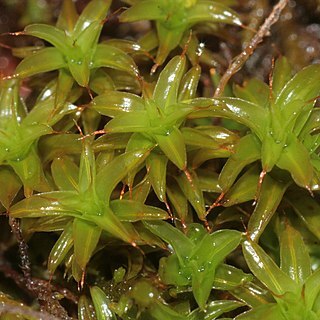Stems 8-25 mm Leaves clasping at base, infolded and twisted around the stem when dry, squarrose-recurved when moist, lingulate-ovate, 2.5-3.5 x 1-1.2 mm, canaliculate to keeled; margins tightly revolute in the proximal 3/4; apices acute to acuminate; costa excurrent into a serrulate or sometimes serrate, hyaline awn that is often red at base or throughout but sometimes broadly hyaline at base, papillose abaxially and sometimes serrulate near the apex because of projecting cell ends, red-brown; basal cells abruptly differentiated, rectangular, 45-100 x 16-23 µm, quadrate to narrowly rectangular at the margins; distal cells quadrate, polygonal, or rectangular, 13-18 µm, with 3-6 papillae per cell, bulging, somewhat collenchymatous. Specialized asexual reproduction absent. Sexual condition dioicous. Seta brown, 15-20 mm Capsule red-brown, 3-4 mm, slightly curved, with an abrupt neck; operculum ca. 1.8 mm, brown; peristome ca. 1.8 mm, the upper divisions twisted ca. 2 turns, red, the basal membrane white, 1/3-1/2 the total length. Spores 11-15 µm, papillose.
Plants large. Stems 8-25 mm long, central strand absent. Leaves squarrose-recurved when moist, lingulate-ovate, 2.5-3.5 mm long, channelled; apex acute to acuminate; margins revolute below; costa excurrent as serrulate to serrate, red-brown awn, papillose dorsally. Upper laminal cells papillose; basal cells abruptly differentiated, rectangular to quadrate. Sporophytes not known.

